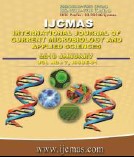


 National Academy of Agricultural Sciences (NAAS)
National Academy of Agricultural Sciences (NAAS)

|
PRINT ISSN : 2319-7692
Online ISSN : 2319-7706 Issues : 12 per year Publisher : Excellent Publishers Email : editorijcmas@gmail.com / submit@ijcmas.com Editor-in-chief: Dr.M.Prakash Index Copernicus ICV 2018: 95.39 NAAS RATING 2020: 5.38 |
The production potential of a crop grown inside a protective structure is directly associated with the microclimatic conditions offered to the crop. Thus, the microclimate should be according to the crop grown for achieving the yield potential. Among the numerous available methods, natural ventilation, shading and evaporative cooling are three commonly used techniques for controlling the microclimate inside protective structures particularly under summer climatic conditions. Natural ventilation helps in dissipating the surplus heat and vapour through exchange between inside and outside air during summer. It excludes the excessive vapour and offers a suitable microclimate favourable to plant growth during winter. Shading has a positive impact on plant growth and development with reduced intensity of solar radiation and air temperature in plant community. Evaporative cooling helps in removing the sensible heat from interior of the protective structure. The greenhouse cooling efficiency can further be increased by combining evaporative cooling with reduced ventilation rate. Thus these techniques can be successfully adopted independently or in combination to obtain more efficient environmental conditions for optimal plant development and productivity.
 |
 |
 |
 |
 |